Active Complement Component 5 (C5) 

CPAMD4; C5a anaphylatoxin; C3 and PZP-like alpha-2-macroglobulin domain-containing protein 4
- UOM
- FOB US$ 260.00 US$ 650.00 US$ 1,300.00 US$ 3,900.00 US$ 9,750.00
- Quantity
Overview
Properties
- Product No.APB969Hu02
- Organism SpeciesHomo sapiens (Human) Same name, Different species.
- ApplicationsCell culture; Activity Assays.
Research use only - DownloadInstruction Manual
- CategoryMetabolic pathwayInfection immunityImmune moleculeHematologyAutoimmunity
- Buffer FormulationPBS, pH7.4, containing 0.01% SKL, 5% Trehalose.
- Traits Freeze-dried powder, Purity > 95%
- Isoelectric Point6.4
Sign into your account
Share a new citation as an author
Upload your experimental result
Review

Contact us
Please fill in the blank.
Activity test

Complement Component 5 (C5), which forms part of the later stages of the complement pathway, is cleaved into C5a and C5b. C5a is a chemotactic agent for neutrophils, while C5b forms part of the complement membrane attack complex. Coagulation Factor II (F2) has been identified as an interactor of C5, thus a functional binding ELISA assay was conducted to detect the interaction of recombinant human C5 and recombinant mouse F2. Briefly, C5 was diluted serially in PBS with 0.01% BSA (pH 7.4). Duplicate samples of 100 μl were then transferred to F2-coated microtiter wells and incubated for 1h at 37℃. Wells were washed with PBST and incubated for 1h with anti-C5 pAb, then aspirated and washed 3 times. After incubation with HRP labelled secondary antibody for 1h at 37℃, wells were aspirated and washed 5 times. With the addition of substrate solution, wells were incubated 15-25 minutes at 37℃. Finally, add 50 µL stop solution to the wells and read at 450/630 nm immediately. The binding activity of recombinant human C5 and recombinant mouse F2 was shown in Figure 1, the EC50 for this effect is 0.22 ug/mL.
Usage
Reconstitute in 10mM PBS (pH7.4) to a concentration of 0.1-1.0 mg/mL. Do not vortex.
Storage
Avoid repeated freeze/thaw cycles. Store at 2-8°C for one month. Aliquot and store at -80°C for 12 months.
Stability
The thermal stability is described by the loss rate. The loss rate was determined by accelerated thermal degradation test, that is, incubate the protein at 37°C for 48h, and no obvious degradation and precipitation were observed. The loss rate is less than 5% within the expiration date under appropriate storage condition.
Increment services
-
 BCA Protein Quantification Kit
BCA Protein Quantification Kit
-
 Molecular Mass Marker for Protein
Molecular Mass Marker for Protein
-
 Monoclonal Antibody Customized Service
Monoclonal Antibody Customized Service
-
 Polyclonal Antibody Customized Service
Polyclonal Antibody Customized Service
-
 Protein Activity Test Experiment Service
Protein Activity Test Experiment Service
-
 Electrophoretic Mobility Shift Assay (EMSA) Experiment Service
Electrophoretic Mobility Shift Assay (EMSA) Experiment Service
-
 Buffer
Buffer
-
 Lentivirus Packaging Experiment Service
Lentivirus Packaging Experiment Service
-
 Adenovirus Packaging Experiment Service
Adenovirus Packaging Experiment Service
-
 Real Time PCR Experimental Service
Real Time PCR Experimental Service
-
 Spike RBD Protein (S-RBD)
Spike RBD Protein (S-RBD)
-
 Protein G
Protein G
-
 Protein A
Protein A
Citations
- Complement activation contributes to the injury and outcome of kidney in human anti-glomerular basement membrane disease.PubMed: 22941511
- Acute and prolonged complement activation in the central nervous system during herpes simplex encephalitisPubmed:27235358
- Complement C5a/C5aR pathway potentiates the pathogenesis Q5 of gastric cancer by down-regulating p21 expressionpubmed:29031586
- iTRAQ‐Based Proteomic Analysis Reveals Protein Profile in Plasma from Children with AutismPubmed:29274201
- Impaired insulin signaling in the B10.D2-Hc H2 H2-T18/oSnJ mouse model of complement factor 5 (C5) deficiencyPubmed: 31084499
- Comparative proteomics analysis of serum proteins in gestational diabetes during early and middle stages of pregnancyPubmed: 31162828
- C5aR deficiency attenuates the breast cancer development via the p38/p21 axisPubmed: 32669478







